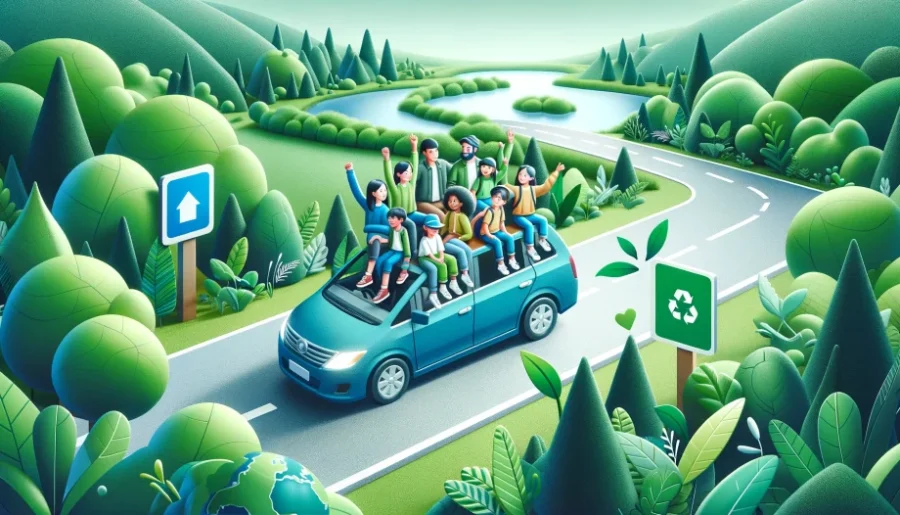
13 Benefits of Carpooling for the Environment provides you with valuable insights into how carpooling can be a game-changer for both your wallets and the planet.
Dive into the 13 benefits of carpooling for the environment and discover how sharing rides can lead to a greener, happier planet. Let’s ride together!
Benefits of Carpooling for the Environment Key Takeaways:
- 13 Benefits of carpooling for the environment include:
- 1. Reducing carbon emissions,
- 2. Saving on fuel costs,
- 3. Decreasing traffic congestion,
- 4. Improving air quality,
- 5. Conserving energy,
- 6. Enhancing social connections,
- 7. Reducing parking space needs,
- 8. Lowering stress levels,
- 9. Promoting sustainable living,
- 10 Improving road safety,
- 11. Offering financial savings,
- 12. Supporting local economies,
- 13. Fostering a sense of community.
Ever wondered how carpooling could make a big difference?
Our article on the 13 benefits of carpooling for the environment unveils how sharing your ride not only cuts down on traffic and saves you money but also plays a pivotal role in reducing our carbon footprint.
Join us as we explore the impactful ways carpooling contributes to a healthier environment and a more connected community.
What is Carpooling?

Carpooling is a shared transportation method where multiple individuals travel together in a single vehicle.
Carpooling is the sharing of car journeys so that more than one person travels in a car, and prevents the need for others to have to drive to a location themselves. Carpooling is considered a Demand-Responsive Transport (DRT) service
By having more people using one vehicle, carpooling reduces each person’s travel costs such as: fuel costs, tolls, and the stress of driving. Carpooling is also a more environmentally friendly and sustainable way to travel as sharing journeys reduces air pollution, carbon emissions, traffic congestion on the roads, and the need for parking spaces. Authorities often encourage carpooling, especially during periods of high pollution or high fuel prices. Car sharing is a good way to use up the full seating capacity of a car, which would otherwise remain unused if it were just the driver using the car. Wikipedia
This approach to commuting is designed to reduce the number of vehicles on the road, thereby offering numerous benefits ranging from cost savings to environmental conservation.
Carpooling can vary from informal arrangements between friends and colleagues to more structured setups facilitated by dedicated platforms.
Here’s a deeper look into carpooling, how it works, and the diverse ways to participate:
- Basic Concept:
- At its core, carpooling involves two or more people sharing a ride to a similar destination or along a common route. This can significantly cut down on individual commuting costs, reduce traffic congestion, and decrease emissions and pollution.
- How It Works:
- Typically, carpool participants agree on a pickup location, time, and route. They also decide on how to share the costs, such as fuel and tolls, and establish a driving schedule if the driving duties are to be rotated among the members.
- Communication and reliability are key to a successful carpool, ensuring that all participants benefit from the arrangement without inconvenience.
- Participation Methods:
- Informal Arrangements: Often, carpooling arrangements start informally among friends, family, neighbors, or colleagues who share similar commutes. These groups can be organized through direct communication or via social media groups.
- Dedicated Carpooling Apps: Numerous apps and websites are designed to facilitate carpooling by matching individuals with similar commuting patterns. These platforms can offer additional features like schedule coordination, expense tracking, and user reviews.
- Workplace Programs: Some organizations implement carpool programs for their employees, providing incentives such as reserved parking, fuel vouchers, or financial rewards to encourage participation.
- Social Media and Online Communities: Platforms like Facebook and community forums can also serve as a means to find carpool partners. Users can post requests or offers for carpooling, allowing them to connect with others in their area.
- Safety and Trust:
- When participating in carpooling, especially with new acquaintances, it’s essential to ensure safety and establish trust among all participants. This can involve meeting in advance, verifying identities, and setting clear expectations about the carpooling arrangement.
- Many carpooling apps include safety features, such as identity verification and user ratings, to help participants feel more secure.
- Flexibility and Adaptability:
- Carpooling offers flexibility, as participants can arrange one-time trips, regular daily commutes, or anything in between. This adaptability makes it a convenient option for a wide range of transportation needs, from daily work commutes to special events.
Carpooling is a versatile, cost-effective, and environmentally friendly way to travel, emphasizing the importance of community and shared resources.
By understanding the basics of how carpooling works and exploring the various ways to participate, individuals can take advantage of this sustainable transportation method to improve their commutes, save money, and reduce their environmental impact.
Carpooling Benefits

The Concept and Its Growing Importance
Carpooling, the practice of sharing a ride with others heading in the same direction, is gaining momentum as a smart solution to several modern-day challenges.
This simple concept is not new, but its relevance is more pronounced today than ever before.
With the rise in the number of vehicles on the roads, the environmental toll of our daily commutes is increasingly significant.
Carpooling emerges as a beacon of hope, offering a straightforward yet impactful way to mitigate this issue.
Environmental and Economic Benefits
By choosing to carpool, individuals can play a direct role in reducing the carbon footprint associated with their travel.
This method of commuting doesn’t just lessen the environmental impact; it also offers a practical way to cut down on travel expenses.
Fuel costs, toll fees, and maintenance expenses can add up quickly for anyone driving alone.
Sharing these costs among passengers makes financial sense and lightens the load on each person’s wallet.
Enhancing Social Connections
Beyond the tangible benefits of cost and environmental conservation, carpooling nurtures a sense of community.
It transforms mundane drives into opportunities for socialization, allowing people to connect, share experiences, and build new friendships.
In a world where busy schedules and digital distractions often isolate us, carpooling provides a rare chance to engage with others in meaningful ways.
A Multifaceted Solution
In summary, carpooling stands out as a multifaceted solution that addresses the pressing issues of our times.
It’s a testament to how collective action in our daily routines can lead to significant environmental, economic, and social benefits.
As we move forward, embracing carpooling could be a key step in our journey toward a more sustainable and connected world.
Exploring the Benefits of Carpooling

- Introduction to the Topics
We’re diving deep into the benefits of carpooling. Each benefit shows how sharing rides can change our lives and the planet for the better. - Economic and Environmental Gains
First, we’ll discuss cost savings and environmental benefits. Carpooling saves money and reduces our carbon footprint. - Improving Daily Life
Next, we look at reduced stress and less traffic congestion. Carpooling can make commutes faster thanks to carpool lanes. It also offers more social interactions. - Building Connections
We’ll explore how carpooling helps build friendships. It creates a sense of community among participants. - Practical Advantages
The discussion will include increased fuel efficiency and longer vehicle life. Carpooling leads to lower transportation costs overall. - Valuing Time
Finally, we’ll highlight the gift of time. Carpooling saves time that can be used in more meaningful ways.
These sections aim to provide a clear view of carpooling’s broad benefits. They encourage readers to consider carpooling as a positive change in their daily routine.
1. Cost Savings
Carpooling offers a straightforward way to reduce commuting costs. By sharing rides, individuals can significantly cut down on expenses related to fuel, tolls, and parking.
This section explores the financial benefits of carpooling, including how it can lead to substantial savings and even earn you incentives.
- Fuel Savings:
- Share fuel costs among passengers.
- Increase overall fuel efficiency per commute.
- Lower Toll Expenses:
- Split toll fees when traveling on toll roads.
- Reduced Parking Costs:
- Pay less by dividing parking fees.
- Access to designated carpool parking spots at a reduced rate or prime locations.
- Tax Credits and Incentives:
- Benefit from government or local authority incentives for carpoolers.
- Possible employer benefits, such as premium parking or financial incentives.
Carpooling not only eases the financial burden of commuting but also offers rewards and benefits that make it an even more appealing option.
2. Environmental Benefits
Carpooling goes beyond just saving money; it plays a crucial role in reducing our environmental impact.
By sharing rides, we decrease the number of vehicles on the road, which directly leads to lower carbon emissions and improved air quality.
Here’s how carpooling makes a difference:
- Lower Carbon Footprint:
- Fewer cars on the road mean less fuel consumption overall.
- Reduces the per-capita carbon emissions by sharing rides.
- Reduced Greenhouse Gas Emissions:
- Carpooling significantly cuts down on the amount of CO2 and other harmful greenhouse gases released into the atmosphere.
- Even a small reduction in daily vehicle use can lead to a substantial decrease in annual greenhouse gas emissions.
- Less Traffic Congestion:
- Fewer vehicles contribute to smoother traffic flow.
- Reduced congestion leads to shorter idling times and lower emissions per trip.
- Improved Air Quality:
- With fewer cars emitting exhaust gases, the quality of air in urban areas improves.
- Benefits public health by reducing pollution-related respiratory issues.
- Conservation of Resources:
- Decreases the demand for fossil fuels, contributing to energy conservation.
- Supports the longevity of our planet’s natural resources by promoting more sustainable transportation options.
Carpooling embodies an effective way to combat climate change and protect our environment.
By opting to share our rides, we can collectively make a significant impact on reducing air pollution and conserving natural resources.
3. Reduced Stress
Carpooling not only benefits your wallet and the planet but also contributes significantly to lowering daily stress levels.
By sharing the driving responsibilities, individuals can enjoy a more relaxed commute, turning what was once a tense time into a period of leisure or productivity.
Here’s how carpooling leads to a less stressful journey:
- Shared Driving Duties:
- Alternating drivers means less frequent driving for each person, reducing the fatigue and stress associated with daily commutes.
- Allows for breaks from driving, providing time to relax or catch up on rest.
- More Leisure Time:
- Passengers can use the time to read, work, or engage in hobbies, making the commute more enjoyable and productive.
- This leisure time can contribute to a better work-life balance, reducing overall stress levels.
- Social Interaction:
- Carpooling creates opportunities for socialization, which can be a great stress reliever.
- Conversations with carpool mates can help distract from daily worries and foster a supportive community feel.
- Reduced Commute Anxiety:
- Knowing you’re not alone in the commute can ease the anxiety associated with traffic jams and rushing to work.
- The camaraderie of carpooling offers a sense of security and shared experience.
- Efficient Commuting:
- Utilizing carpool lanes often leads to faster travel times, reducing the stress of being late.
- Less time in traffic means more time for personal activities, further decreasing stress.
Carpooling transforms the commute from a solo battle with traffic into a shared, more enjoyable experience.
It not only diminishes the physical and mental toll of driving but also enhances the overall quality of life by providing more personal time and reducing daily anxieties.
4. Decreased Traffic Congestion
Carpooling plays a pivotal role in alleviating traffic congestion, a common headache for cities worldwide.
By reducing the number of vehicles on the road, carpooling contributes to a smoother flow of traffic and fewer traffic jams.
Here are the ways carpooling helps in decreasing traffic congestion:
- Fewer Cars, Smoother Traffic:
- Every carpool effectively removes multiple vehicles from the road, leading to less congested roads.
- The reduction in vehicles directly translates to smoother traffic flow and faster commute times for everyone.
- Optimized Use of Road Space:
- Carpooling maximizes the efficiency of the available road space. More people traveling in fewer cars means more efficient use of highways and streets.
- This optimization can delay or negate the need for costly road infrastructure expansions.
- Reduced Peak-Time Traffic Volume:
- Carpooling is most beneficial during peak commuting hours when traffic congestion is at its worst.
- By consolidating commutes, carpooling significantly reduces the volume of traffic during these critical times.
- Enhanced Effectiveness of Transit Lanes:
- Carpool and high occupancy vehicle (HOV) lanes encourage drivers to carpool, offering faster routes as an incentive.
- These lanes keep traffic moving more smoothly, even during heavy congestion periods.
- Positive Feedback Loop:
- As more people experience the benefits of carpooling, it encourages further participation.
- This growing trend can lead to a significant decrease in traffic congestion over time, creating a more sustainable and efficient transportation system.
Carpooling not only provides immediate benefits by easing daily commutes but also contributes to long-term solutions for traffic management.
By encouraging more people to share rides, we can significantly reduce the stress and environmental impact of urban transportation.
5. Faster Commute Using Carpool Lanes
One of the most tangible benefits of carpooling is the ability to use high occupancy vehicle (HOV) lanes, often referred to as carpool lanes.
These lanes are reserved exclusively for vehicles with multiple occupants, providing a faster and more efficient route during busy commuting hours.
Here’s how access to HOV lanes benefits carpoolers:
- Bypass Traffic Jams:
- HOV lanes are typically less congested than general-purpose lanes. Carpoolers can avoid the bulk of traffic jams, significantly reducing commute times.
- This advantage is particularly noticeable during peak traffic hours when most lanes are congested.
- Consistent Travel Times:
- The use of HOV lanes offers more predictable and reliable commute times. Carpoolers can often bypass the variable delays that affect the main traffic lanes.
- This reliability makes planning and time management easier for daily schedules.
- Incentive for Carpooling:
- The prospect of accessing faster lanes encourages more drivers to consider carpooling. It’s a practical incentive that benefits both the environment and the commuters.
- As more people carpool to use these lanes, overall traffic congestion decreases, creating a positive cycle.
- Energy and Cost Efficiency:
- Faster commutes mean vehicles spend less time on the road, which can lead to savings on fuel consumption and lower emissions.
- This efficiency not only benefits the carpoolers but also contributes to broader environmental goals.
- Supports Public Policy Goals:
- HOV lanes are a part of many regions’ strategies to reduce traffic congestion and environmental impact. By utilizing these lanes, carpoolers support public policy goals aimed at creating more sustainable urban mobility.
- These policies often extend to further benefits and incentives for carpoolers, including parking privileges and toll discounts.
Access to HOV lanes significantly enhances the carpooling experience by providing a quicker, more efficient commute.
This benefit not only saves time but also serves as a key motivator for individuals to adopt carpooling as a regular part of their transportation routine.
6. More Social
Carpooling extends beyond environmental and economic advantages, offering a rich social dimension to daily commutes.
It turns travel time into an opportunity for building new friendships and enhancing existing social connections.
Here’s a closer look at the social benefits of carpooling:
- Building New Friendships:
- Regular carpooling creates a shared space for interaction, allowing individuals to meet new people and form friendships.
- The daily commute becomes a time to connect, share interests, and engage in meaningful conversations.
- Strengthening Existing Relationships:
- Carpooling with colleagues or neighbors can strengthen bonds by spending more time together outside of the usual environment.
- It provides a relaxed setting to discuss ideas, share personal stories, and develop deeper connections.
- Expanding Professional Networks:
- Sharing rides with people from similar or related fields can lead to valuable networking opportunities.
- Conversations during the commute can uncover shared professional interests, potentially leading to collaborations or job opportunities.
- Enhancing Communication Skills:
- Regular interaction with carpool mates can improve social and communication skills.
- Engaging with a variety of personalities helps in developing better interpersonal understanding and empathy.
- Creating a Supportive Community:
- Carpool groups often evolve into supportive communities, where members help each other beyond just sharing rides.
- This support can range from sharing resources and advice to assisting in times of need.
- Boosting Mental Health:
- The social interaction within a carpool can have a positive effect on mental health, reducing feelings of isolation and stress.
- Starting and ending the day with friendly faces and conversation can significantly uplift one’s mood.
Carpooling’s social aspect introduces a human element to the mundane task of commuting, transforming it into a rich, interpersonal experience.
By fostering a sense of community and belonging, carpooling can significantly enrich the daily lives of its participants.
7. Reduces Emissions
Carpooling stands as a powerful tool in the fight against climate change, primarily through its ability to significantly reduce carbon emissions from personal transportation.
By sharing rides, fewer cars are on the road, which directly leads to a decrease in the amount of carbon dioxide and other harmful pollutants released into the atmosphere.
Here’s an in-depth look at how carpooling contributes to emission reductions:
- Lower Per-Capita Emissions:
- When individuals carpool, the emissions produced by a single vehicle are shared among the passengers, drastically lowering the per-capita carbon footprint of each commute.
- This collective reduction can have a profound impact when considered on a global scale.
- Decreased Fuel Consumption:
- Carpooling leads to more efficient use of fuel, as more people are transported using the same amount of energy.
- This efficiency not only saves money but also results in lower overall demand for fossil fuels, further reducing emissions.
- Reduced Need for Multiple Vehicles:
- By encouraging people to use fewer cars, carpooling directly cuts down on the total emissions generated during peak travel times.
- This is particularly impactful in urban areas, where traffic congestion and vehicle emissions are highest.
- Support for Sustainable Urban Planning:
- Increased carpooling can influence urban planning and transportation policies, promoting infrastructure that supports lower emissions and alternative modes of transportation.
- Encouraging carpooling can lead to a broader adoption of eco-friendly transportation solutions.
- Contribution to Climate Goals:
- Carpooling aligns with international and national goals for reducing greenhouse gas emissions and combating climate change.
- Collective action through carpooling can significantly contribute to achieving these targets, showcasing how individual choices can lead to global benefits.
- Catalyst for Behavioral Change:
- Choosing to carpool can inspire further environmentally conscious behaviors among individuals, creating a culture of sustainability.
- This shift in mindset is crucial for long-term changes in how societies view and manage their environmental impact.
Carpooling’s role in reducing emissions is a clear example of how simple changes in daily habits can contribute to significant environmental benefits.
By choosing to share rides, individuals can take an active part in reducing their carbon footprint, combating climate change, and promoting a healthier planet for future generations.
8. Reduces Pollution
Carpooling has a direct and positive impact on air quality by significantly reducing the amount of exhaust gases released into the atmosphere.
Each carpooling arrangement decreases the number of vehicles on the road, leading to a decrease in pollutants that contribute to air pollution.
Here’s how carpooling helps in reducing pollution and improving air quality:
- Decrease in Exhaust Emissions:
- Fewer vehicles on the road mean fewer sources of exhaust emissions, which are major contributors to air pollution.
- Carpooling reduces the levels of nitrogen oxides, carbon monoxide, and particulate matter, all harmful pollutants released from vehicle exhausts.
- Improvement in Urban Air Quality:
- In densely populated urban areas, where air quality is often poorest, carpooling can significantly reduce the concentration of air pollutants.
- Better air quality leads to healthier living conditions and reduces the risk of respiratory diseases among the urban population.
- Contribution to Smog Reduction:
- Vehicle emissions are a key factor in the formation of smog, a persistent problem in many cities worldwide.
- By reducing the number of cars emitting pollutants, carpooling helps lower the formation of smog, contributing to clearer skies and improved health outcomes.
- Mitigation of Greenhouse Gas Effect:
- Beyond just local air pollutants, carpooling also reduces greenhouse gas emissions, which are critical to managing global warming and climate change.
- Lowering the concentration of these gases in the atmosphere helps mitigate the greenhouse effect and its impact on global temperatures.
- Support for Environmental Sustainability:
- By improving air quality, carpooling supports broader environmental sustainability goals, including the conservation of ecosystems affected by pollution.
- This holistic approach to transportation can encourage more sustainable lifestyle choices across communities.
- Long-Term Health Benefits:
- Improved air quality has long-term health benefits, reducing the prevalence of asthma, allergies, and other respiratory or cardiovascular diseases.
- Cleaner air means a healthier environment for current and future generations.
Carpooling’s effectiveness in reducing pollution is a testament to the power of collective action in addressing environmental challenges.
By opting to share rides, individuals not only contribute to a reduction in air pollution but also play a part in creating a cleaner, healthier environment for everyone.
9. Building Friendships
Carpooling serves as a unique social platform that naturally fosters the development of new friendships and strengthens existing ones.
Through the shared experience of commuting, individuals find themselves in an environment ripe for socialization, bonding, and mutual support.
Here’s a closer look at how carpooling contributes to building friendships:
- Foundation for New Friendships:
- Regular carpool arrangements provide a consistent opportunity for individuals to interact in a relaxed setting, laying the groundwork for new friendships.
- The daily commute becomes a shared journey, allowing individuals to get to know each other beyond surface-level interactions.
- Strengthening Existing Bonds:
- For colleagues or neighbors who choose to carpool, the shared rides can significantly deepen their relationships.
- Commuting together offers additional time to connect, discuss personal interests, and support each other in ways that might not be possible in other contexts.
- Shared Experiences and Memories:
- The unique experiences and sometimes unexpected adventures that come with carpooling can create lasting memories and stories to share, further cementing friendships.
- From singing along to favorite songs to navigating through unexpected traffic challenges, these shared moments contribute to a stronger bond.
- Diversity of Perspectives:
- Carpooling brings together individuals from various backgrounds, offering a rich tapestry of perspectives and life experiences.
- This diversity enriches conversations and allows participants to learn from each other, broadening their understanding and appreciation of different viewpoints.
- Support System:
- Beyond the commute, carpool groups often evolve into a supportive network, offering assistance and encouragement in other areas of life.
- Whether it’s career advice, personal growth, or simply a listening ear, the friendships formed through carpooling can provide a valuable support system.
- Community Feeling:
- Carpooling creates a sense of community among participants, fostering a feeling of belonging and mutual care.
- This community aspect can be particularly meaningful in today’s fast-paced and often isolated lifestyles, providing a sense of connection and togetherness.
Carpooling transcends its practical function as a transportation solution, becoming a meaningful social experience that nurtures friendships and community.
By sharing rides, individuals not only contribute to environmental and economic benefits but also enrich their social lives through the connections and friendships they build along the way.
10. Increased Fuel Efficiency
Carpooling significantly enhances fuel efficiency, making it an economically and environmentally smart choice.
Distributing the fuel usage across more passengers ensures that each trip is utilized to its maximum potential, leading to considerable savings on fuel costs and a reduction in the overall gasoline demand.
Here’s an in-depth look at how carpooling contributes to increased fuel efficiency:
- Optimized Vehicle Use:
- Carpooling maximizes the utility of a single vehicle by transporting multiple passengers at once. This efficiency means that for every carpool journey, the amount of fuel consumed is divided among the passengers, effectively reducing the per-person fuel usage.
- This approach contrasts sharply with the inefficiency of single-occupancy vehicles, where one person’s commute uses the same amount of fuel that could transport several people.
- Reduction in Fuel Consumption:
- With fewer vehicles on the road thanks to carpooling, the cumulative demand for fuel decreases. This reduction in demand not only leads to lower fuel costs for individuals but also contributes to a decrease in the overall consumption of fossil fuels.
- This collective saving is significant in terms of both economic benefits and environmental impact, as it directly correlates to fewer emissions per capita.
- Economies of Scale:
- The principle of economies of scale applies to carpooling, where the ‘cost’ of fuel per passenger diminishes as the number of passengers increases. Essentially, the more people sharing a ride, the lower the fuel cost per individual.
- This efficiency makes carpooling an attractive option for regular commutes, especially for those looking to save on transportation costs.
- Encouragement of Efficient Vehicles:
- Carpooling can also encourage the use of more fuel-efficient vehicles. When forming a carpool, groups may opt to use the most efficient vehicle available among them, further enhancing fuel savings and reducing environmental impact.
- Over time, this preference can influence vehicle purchase decisions, pushing the market towards more efficient and environmentally friendly options.
- Contribution to Reduced Traffic Congestion:
- By decreasing the number of cars on the road, carpooling contributes to less traffic congestion, which in turn reduces the amount of idling and stop-and-go driving—a major contributor to inefficient fuel use.
- Smoother traffic flow allows for more consistent driving speeds, which is more fuel-efficient than the variable speeds of congested traffic.
Carpooling’s ability to increase fuel efficiency is a clear win-win, offering tangible benefits for the environment and the wallets of those who participate.
By making the most of each journey’s fuel consumption, carpooling stands as a practical step towards more sustainable and cost-effective transportation.
11. Prolong the Life of Your Vehicle
Carpooling not only promotes sustainability and social connectivity but also offers significant benefits in terms of vehicle longevity.
By sharing driving duties, the wear and tear on any single vehicle are substantially reduced, which can lead to a longer lifespan for the car and decreased maintenance costs.
Here’s a closer look at how carpooling contributes to vehicle longevity:
- Reduced Mileage:
- Regular carpooling means that each participant’s vehicle is used less frequently, leading to lower overall mileage. Lower mileage translates directly into slower depreciation and less wear on the vehicle’s engine, chassis, and other critical components.
- This reduction in mileage helps maintain the vehicle’s value and operational efficiency over time.
- Decreased Wear and Tear:
- Vehicles subjected to less frequent use experience slower rates of wear and tear. This includes less stress on tires, brakes, and suspension systems, which are among the most commonly replaced parts.
- By sharing the commuting burden, carpoolers can extend the intervals between maintenance appointments, saving money and time.
- Lower Maintenance Costs:
- Less wear on the vehicle naturally results in lower maintenance and repair costs. Fewer oil changes, brake pad replacements, and tire rotations are needed, contributing to substantial savings over the life of the vehicle.
- These savings are not just beneficial for the car owner but also contribute to more sustainable consumption of automotive parts and resources.
- Improved Vehicle Efficiency:
- Vehicles maintained in better condition through reduced use tend to operate more efficiently. This means better fuel economy and lower emissions, further enhancing the environmental benefits of carpooling.
- Efficient vehicles also tend to have fewer mechanical issues, contributing to a longer usable life.
- Balanced Usage Among Vehicles:
- In carpool groups, driving duties are often rotated among the members, balancing the usage across multiple vehicles. This practice not only evens out wear and tear but also promotes a sense of fairness and shared responsibility among the group.
- Balanced vehicle usage ensures that no single car is overly burdened, helping all the vehicles in the carpool circle to last longer.
Carpooling offers a strategic approach to vehicle management, ensuring that cars are used as efficiently and sustainably as possible.
By participating in a carpool, individuals can significantly reduce the physical impact on their vehicles, leading to a longer lifespan, reduced maintenance costs, and overall better vehicle health.
This benefit, combined with the environmental and social advantages of carpooling, makes it an attractive option for commuters looking to optimize their transportation solutions.
12. Reduced Transportation Costs
Carpooling significantly lowers the financial burden associated with daily transportation, offering a broad spectrum of savings beyond just fuel costs.
By sharing rides, individuals can enjoy reduced expenses on maintenance, parking, and the overall costs of owning and operating a vehicle.
Here’s how carpooling contributes to a more economical approach to transportation:
- Savings on Maintenance and Repairs:
- The reduced wear and tear on vehicles from less frequent use results in lower maintenance and repair costs. Routine expenses such as oil changes, brake replacements, and tire wear are minimized, contributing to long-term savings.
- Regular carpooling can extend the intervals between service appointments, keeping maintenance costs more manageable.
- Lower Parking Expenses:
- Parking fees, especially in urban areas and at employment sites, can accumulate to a significant monthly expense. Carpoolers can split these costs, reducing the individual financial impact.
- Some locations offer discounted or even free parking for carpool vehicles, further enhancing the savings.
- Decreased Depreciation:
- Vehicles that accrue mileage more slowly tend to depreciate at a slower rate. This slower depreciation preserves the vehicle’s resale value over time, offering financial benefits when it’s time to sell or trade-in.
- Lower mileage vehicles attract higher resale values, translating to better financial returns for the owner.
- Insurance Discounts:
- Some insurance companies offer discounts for vehicles used in carpooling, recognizing the reduced risk and wear associated with shared driving responsibilities.
- These discounts can lead to significant annual savings on insurance premiums, further reducing the overall cost of vehicle ownership.
- Efficient Use of Resources:
- By maximizing the passenger capacity of each vehicle, carpooling represents a more efficient use of resources. This efficiency not only reduces individual costs but also contributes to a more sustainable transportation ecosystem.
- The collective savings from carpooling can be redirected to other financial goals or investments, improving personal financial health.
- Public Transportation Savings:
- For those who alternate between carpooling and public transportation, carpooling can offer a more cost-effective alternative to daily tickets or passes, especially when public transit options are expensive or inconvenient.
- This flexibility allows individuals to choose the most economical mode of transportation on a day-to-day basis.
Carpooling’s role in reducing transportation costs is comprehensive, touching on every aspect of vehicle ownership and operation.
By embracing carpooling, commuters not only contribute to a more sustainable environment but also enjoy a wide range of financial benefits, making it an intelligent choice for cost-conscious individuals.
13. Time
Carpooling offers a valuable commodity that many of us wish we had more of namely time.
Beyond the straightforward reduction in commuting time, especially when utilizing carpool lanes, carpooling also minimizes the time spent on vehicle maintenance and searching for parking.
This overall time savings can significantly enhance daily productivity and personal well-being.
Here’s a closer look at how carpooling contributes to time efficiency:
- Faster Commutes in Carpool Lanes:
- Access to high occupancy vehicle (HOV) lanes allows carpoolers to bypass traffic congestion, directly reducing the time spent on the road.
- This expedited travel not only shortens the commute but also contributes to a more predictable and stress-free journey.
- Reduced Time for Vehicle Maintenance:
- With less frequent use, vehicles require servicing less often, which means fewer trips to the mechanic or dealership for maintenance.
- This reduction in maintenance needs can save carpoolers several hours over a year, providing more time for personal or professional activities.
- Minimized Parking Hassles:
- Searching for parking can be a significant time sink, especially in crowded urban areas. Carpooling reduces the number of vehicles needing parking spaces, easing this burden.
- Additionally, carpoolers often benefit from designated parking spots that are closer to their destination, further reducing time spent parking.
- Streamlined Daily Routines:
- Carpooling can help streamline daily routines by setting a fixed schedule for departure and arrival, encouraging efficiency in morning and evening routines.
- This predictability helps in better time management and planning for the day ahead, potentially freeing up time for other important tasks or leisure activities.
- Enhanced Productivity:
- For passengers, the commute time can be used productively to catch up on work, read, or engage in other activities, turning otherwise lost time into valuable, usable minutes.
- This ability to multitask can significantly increase daily productivity, contributing to a more balanced and fulfilling lifestyle.
- Social Time with Carpool Mates:
- The time spent in a carpool can also serve as a social or relaxation period, allowing individuals to engage with friends or colleagues, share interests, and decompress from the day.
- This social interaction can enhance mental well-being, making time spent commuting feel more valuable and less like a chore.
Carpooling’s impact on time efficiency extends beyond just the commute, offering a more holistic approach to managing our daily schedules.
By saving time on the road, reducing the need for frequent vehicle maintenance, and minimizing parking woes, carpooling frees up precious hours for more meaningful pursuits, ultimately enhancing the quality of life for its participants.
Facts About Carpooling

Carpooling has increasingly become a focal point in discussions about sustainable transportation, offering a multitude of benefits that impact both individuals and the environment.
The following statistics and facts highlight the significance of carpooling, showcasing its environmental, economic, and social advantages:
- Environmental Impact:
- A single carpool with four passengers can reduce greenhouse gases by approximately three-quarters compared to four people driving separately. This significant reduction underscores carpooling’s role in combating climate change.
- The United States Environmental Protection Agency (EPA) estimates that if every commuter car in the U.S. carried just one additional passenger, the country could save 33 million gallons of gasoline every day.
- Economic Benefits:
- According to the American Automobile Association (AAA), the average annual cost to own and operate a vehicle is over $9,000. Carpooling can substantially reduce these costs by splitting expenses like fuel, tolls, and parking fees among passengers.
- Carpoolers can save up to $1,000 a year on parking and fuel costs alone, not including the potential savings from reduced wear and tear on their vehicles.
- Traffic Congestion:
- The Texas A&M Transportation Institute reports that the average American commuter spends about 42 hours a year stuck in traffic. Carpooling can alleviate traffic congestion, potentially saving hundreds of hours over a lifetime.
- Carpooling reduces the number of vehicles on the road, which can significantly decrease traffic congestion, especially during peak hours. This not only saves time but also reduces stress associated with commuting.
- Social and Health Benefits:
- A study published in the American Journal of Preventive Medicine found that people who commute in groups, such as carpooling, are less likely to experience loneliness and have higher social satisfaction compared to those who commute alone.
- Reducing the number of vehicles on the road also lowers air pollution levels, which can lead to better health outcomes for the population, particularly in urban areas where air quality is a major concern.
- Utilization of Resources:
- It’s estimated that most personal vehicles are used only 5% of the time, sitting idle for the remaining 95%. Carpooling increases the utilization rate of vehicles, making more efficient use of the automotive resources already on the road.
- The average occupancy of a commuting vehicle in the U.S. is about 1.1 persons. Increasing this number through carpooling could dramatically reduce the number of vehicles needed for commuting, further enhancing environmental and economic benefits.
These facts about carpooling paint a clear picture of its advantages. By choosing to share rides, individuals can contribute to a more sustainable and efficient transportation system, enjoy significant cost savings, reduce their environmental footprint, and even improve their social well-being and health.
Here’s a table summarizing the key facts about carpooling, highlighting its environmental, economic, and social impacts:
| Aspect | Fact |
|---|---|
| Environmental Impact | – Reduces greenhouse gases by approximately three-quarters with four passengers compared to driving separately.<br>- Saves 33 million gallons of gasoline every day if every commuter car in the U.S. carried just one additional passenger. |
| Economic Benefits | – Can reduce annual vehicle operation costs significantly, with potential savings on parking and fuel costs alone reaching up to $1,000 a year.<br>- The average annual cost to own and operate a vehicle exceeds $9,000. |
| Traffic Congestion | – The average American commuter spends about 42 hours a year in traffic. Carpooling can significantly reduce this time.<br>- Decreases traffic congestion, especially during peak hours, by reducing the number of vehicles on the road. |
| Social and Health Benefits | – Carpoolers are less likely to experience loneliness and have higher social satisfaction.<br>- Improves air quality, leading to better health outcomes for the population. |
| Utilization of Resources | – Increases the utilization rate of vehicles, which are typically used only 5% of the time.<br>- The average occupancy of a commuting vehicle in the U.S. is about 1.1 persons; carpooling can significantly improve this. |
This table encapsulates the broad spectrum of benefits associated with carpooling, from reducing environmental impact and alleviating traffic congestion to saving money and enhancing social connections.
Carpooling Advantages and Disadvantages
Carpooling offers a range of benefits but, like any transportation method, comes with its own set of challenges.
Understanding both sides can help individuals make informed decisions about incorporating carpooling into their routines.
Here’s a balanced view of the advantages and disadvantages of carpooling, along with suggestions for mitigating potential drawbacks.
Advantages
- Environmental Benefits: Reduces carbon emissions and pollution, contributing to cleaner air and a healthier planet.
- Cost Savings: Significantly lowers individual expenses on fuel, maintenance, parking, and tolls by sharing these costs among passengers.
- Reduced Traffic Congestion: Fewer cars on the road mean less congestion, leading to quicker and more predictable commute times.
- Social Interaction: Offers opportunities to meet new people, strengthen existing relationships, and enhance social well-being.
- Stress Reduction: Sharing driving duties and avoiding the hassle of navigating through heavy traffic can lower stress levels.
Disadvantages
- Scheduling Conflicts: Coordinating schedules among multiple people can be challenging, potentially leading to delays or inconveniences.
- Loss of Flexibility: Being part of a carpool may limit the ability to run errands or make spontaneous plans after work.
- Privacy Concerns: Sharing personal space with others on a daily basis might not be comfortable for everyone.
- Compatibility Issues: Differences in personal habits, preferences, or the purpose of trips can lead to discomfort or conflicts.
Mitigating Challenges
- Flexible Scheduling: Establish a rotating schedule that accommodates the occasional need for flexibility, allowing members to opt out when necessary without disrupting the group.
- Clear Communication: Use group chats or carpooling apps to keep everyone informed and make adjustments as needed. Regularly discuss and align on preferences and rules.
- Compatibility Matching: When forming or joining a carpool, consider compatibility in terms of personalities, cleanliness, music preferences, and smoking policies to ensure a comfortable ride for everyone.
- Backup Plans: Have a contingency plan for situations when carpooling isn’t feasible, such as using public transportation, ride-sharing services, or biking.
While carpooling presents some challenges, many of these can be effectively managed through open communication, flexibility, and a bit of planning.
The advantages, particularly in terms of environmental impact, cost savings, and reduced traffic congestion, often outweigh the potential downsides, making carpooling a worthwhile consideration for many commuters.
How Does Carpooling Reduce Traffic?
Carpooling’s impact on traffic flow and congestion is profound and multifaceted.
By reducing the number of cars on the road, it addresses several underlying causes of traffic congestion, leading to smoother traffic conditions and more efficient use of transportation infrastructure.
Here’s a deeper look into the mechanics of how carpooling helps reduce traffic:
Decreased Volume of Vehicles
- Direct Reduction in Cars: The most straightforward impact of carpooling is the direct reduction in the number of vehicles on the road. When individuals choose to share rides instead of driving separately, this immediately decreases the total volume of cars, especially during peak commuting hours.
- Efficient Use of Space: Roads have a finite capacity, and every carpool can remove two or more vehicles from the road, significantly freeing up space. This efficient use of road space can dramatically reduce bottlenecks and the overall density of traffic.
Improved Traffic Flow
- Reduction in Start-Stop Traffic: Carpooling can lead to smoother traffic flow. With fewer cars, there’s less braking and acceleration, which are common causes of start-stop traffic. This smoother flow not only speeds up commute times but also reduces the risk of accidents.
- Enhanced Utilization of Carpool Lanes: Many regions have dedicated high occupancy vehicle (HOV) lanes that are reserved for carpools and buses. These lanes often move much faster than regular lanes during rush hours, providing an incentive for carpooling and further reducing congestion in the general-purpose lanes.
Environmental and Behavioral Impacts
- Lower Emissions and Cleaner Air: Reduced traffic congestion also means less idling and fewer emissions per vehicle. Cleaner air can have a significant impact on urban areas, where pollution from cars contributes to health problems and environmental degradation.
- Cultural Shift Towards Shared Mobility: As more people adopt carpooling, it promotes a cultural shift towards considering shared mobility as a viable alternative to single-occupancy vehicles. This shift can lead to broader support for infrastructure and policies that prioritize efficient transportation options.
Network Effects
- Cumulative Benefits: The benefits of carpooling are cumulative. As carpooling becomes more widespread, the reduction in traffic congestion can lead to even greater efficiencies and more significant decreases in travel times across the network.
- Feedback Loop: The visible benefits of carpooling, such as faster commutes and reduced congestion, can encourage more people to participate, creating a positive feedback loop that further alleviates traffic conditions.
Carpooling’s role in reducing traffic congestion is clear and significant.
Through a combination of direct reductions in the number of vehicles, improved traffic flow, environmental benefits, and cultural shifts towards shared mobility, carpooling presents a powerful tool in the quest for more sustainable and efficient urban transportation systems.
FAQs: Understanding Carpooling
Carpooling offers a range of benefits that extend well beyond simply getting from point A to point B.
From environmental advantages to economic savings and social benefits, carpooling is a multifaceted solution to many of today’s transportation challenges.
In this section, we address some of the most common questions about carpooling, providing insights into how it works and the positive impacts it can have on individuals and communities alike.
Q: What are the benefits of carpooling?
A: Carpooling benefits include reduced transportation costs, lower carbon emissions, decreased traffic congestion, and improved air quality.
It also offers social benefits by providing opportunities for people to build friendships and strengthen connections with others.
Q: What are the environmental benefits of ride-sharing?
A: The environmental benefits of carpooling are significant. It reduces the number of vehicles on the road, which in turn lowers greenhouse gas emissions and air pollutants.
This contributes to cleaner air, lessens the impact of climate change, and promotes a healthier environment.
Q: What are the environmental benefits of ride-sharing?
A: Economically, carpooling helps individuals save money on fuel, parking, tolls, and vehicle maintenance costs by sharing these expenses with others.
It also reduces the need for extensive road infrastructure and lowers the societal costs associated with air pollution and traffic congestion.
Q: In what ways does carpooling provide solutions to transportation challenges?
A: Carpooling offers solutions by maximizing the efficiency of the existing vehicle fleet, reducing the demand for parking spaces, alleviating traffic congestion, and providing a cost-effective alternative to single-occupancy vehicle trips. It also supports more sustainable urban planning and transportation systems.
Q: How does carpooling play a role in reducing air pollution?
A: By decreasing the number of cars on the road, carpooling significantly reduces the volume of exhaust gases released into the atmosphere, which are a major source of air pollution. This leads to improved air quality, especially in urban areas where traffic congestion is a significant problem.
Q: What are the social impacts of carpooling?
A: Socially, carpooling encourages interaction among individuals, fostering a sense of community and belonging.
It can lead to new friendships and stronger social networks, providing a more enjoyable and connected commuting experience.
Moreover, it helps reduce the stress and isolation often associated with commuting alone.
Carpooling stands out as a practical and effective way to address many of the challenges facing today’s transportation systems.
By choosing to share rides, individuals can contribute to a more sustainable, economical, and socially enriching travel experience.
Conclusion: Embracing the Benefits of Carpooling
Throughout this exploration of carpooling, we’ve delved into its myriad benefits, from environmental advantages to economic savings and social connections.
Carpooling presents a compelling case as a sustainable, efficient, and community-building mode of transportation.
As we wrap up, let’s revisit the key points and consider the broader implications of adopting carpooling into our daily lives.
Environmental Stewardship
Carpooling significantly reduces greenhouse gas emissions and air pollutants, directly contributing to cleaner air and a healthier planet. By sharing rides, we can play an active role in combating climate change and promoting environmental sustainability.
Economic Savings
The cost benefits of carpooling are undeniable. Participants enjoy savings on fuel, parking, tolls, and maintenance costs. These savings not only benefit individual commuters but also contribute to a more economically efficient transportation system overall.
Social Connections
Beyond its practical advantages, carpooling offers valuable social benefits. It fosters new friendships, strengthens existing relationships, and builds community among participants. This social aspect can transform the daily commute from a solitary task into an enjoyable shared experience.
Traffic and Pollution Reduction
Carpooling addresses some of the most pressing challenges in urban transportation, including traffic congestion and air pollution. By reducing the number of vehicles on the road, carpooling contributes to smoother traffic flow and improved urban air quality.
A Call to Action
As we consider the benefits of carpooling, it’s clear that this simple yet effective practice can have a profound impact on our environment, economy, and social well-being.
Carpooling is more than just a way to get around; it’s a step towards more sustainable and connected living.
By choosing to share our journeys, we can collectively make a difference, paving the way for a greener, more efficient, and socially enriched future.
We encourage readers to explore carpooling as a viable option for their commuting needs.
Whether through informal arrangements with friends and colleagues or by utilizing dedicated carpooling apps and services, there are numerous ways to integrate carpooling into your daily routine.
Together, we can drive positive change, one shared ride at a time.
Read more: Eco-Friendly Transportation: 12 Helpful Ideas
Resources Section
For those interested in the benefits and implementation of carpooling, the U.S. Environmental Protection Agency (EPA) offers comprehensive resources that delve into the environmental, economic, and social advantages of shared mobility solutions, including carpooling.
These resources underscore the importance of reducing individual car usage as a means to mitigate greenhouse gas emissions, ease traffic congestion, and promote a cleaner transportation system.
The EPA highlights carpooling as a key strategy in its broader efforts to combat climate change.
By encouraging the use of greener transportation methods such as biking, walking, public transportation, and carpooling, significant reductions in greenhouse gas emissions can be achieved.
The agency emphasizes the role of employers in offering commuter benefits for carpooling and the use of smart location calculators to minimize commuting times and environmental impacts.
Moreover, driving smarter and choosing energy-efficient vehicles are advocated as additional steps toward a more sustainable future in transportation (EPA Climate Change Transportation).
In its discussion on shared mobility, the EPA explores the evolving landscape of transportation, highlighting the emergence of carsharing, ridesourcing, microtransit, and micromobility options facilitated by advancements in technology.
These shared mobility services are presented as modern extensions of traditional carpooling and vanpooling, offering flexible, efficient, and environmentally friendly alternatives to solo driving.
The agency is actively engaged in research to assess the environmental impacts of these new mobility trends and supports state and local policies aimed at fostering a cleaner transportation ecosystem (EPA Shared Mobility).
Additionally, the EPA provides insights into carpool incentive programs, detailing the benefits for both employees and employers.
Employees enjoy cost-sharing, reduced vehicle wear and tear, and time savings, especially in regions with HOV lanes.
Employers benefit from the need for fewer parking spaces, less employee stress, and improved productivity, underscoring carpooling’s role in creating a more efficient and sustainable commuting environment (EPA Carpool Incentive Programs).
These resources from the EPA serve as valuable guides for individuals, businesses, and policymakers seeking to understand and promote carpooling as a crucial component of a sustainable transportation strategy.
By embracing shared mobility, we can collectively reduce our environmental footprint, enhance economic efficiency, and foster a sense of community through shared travel experiences.
Additional Resources
To provide you with comprehensive insights and reliable information on carpooling, here’s a selection of articles and resources that explore its benefits, environmental impact, and practical aspects.
These resources offer a deep dive into how carpooling can contribute to a more sustainable, efficient, and socially connected form of transportation.
Recommended Articles on Carpooling
- The Financial, Environmental, and Social Benefits of Carpooling
- Overview: This article by Capital One highlights the multifaceted advantages of carpooling, including cost savings, environmental benefits, and social connections. It also discusses some challenges and how to overcome them.
- Read more at Capital One
- The Benefits of Carpooling – Transportation Sustainability Research Center
- Overview: Delve into the societal benefits of carpooling, such as reductions in energy consumption, emissions, congestion, and parking infrastructure demand, detailed by the Transportation Sustainability Research Center.
- Explore the benefits at TSRC
- 15 Benefits of Carpooling to Society and Environment
- Overview: This article outlines 15 ways carpooling can positively impact both society and the environment, including reducing fuel consumption and aiding in the conservation of non-renewable energy sources.
- Learn more at Energy Theory
- Green Commuting: The Environmental Benefits of Carpooling and…
- Overview: A comprehensive look at how carpooling and similar green commuting methods can significantly reduce carbon emissions and contribute to a more sustainable planet.
- Read the full article at Green Earth
- Carpooling 101: Everything You Need to Know for a Sustainable Ride
- Overview: This guide provides a thorough introduction to carpooling, covering its environmental benefits, how it works, and practical tips for those new to carpooling.
- Check it out at Green Citizen
- Why Carpooling Is Good For The Environment – ClimateRealTalk
- Overview: An exploration of carpooling’s role in energy conservation, reducing greenhouse gas emissions, and its overall environmental advantages.
- Discover more at ClimateRealTalk
- The Environmental and Economic Benefits of Carpooling
- Overview: This article focuses on the significant environmental and economic benefits that carpooling brings, such as reduced carbon emissions and lower transportation costs.
- Read about the benefits at Greener Ideal
These resources offer valuable perspectives on the various aspects of carpooling, from its impact on the environment and society to practical advice for individuals looking to adopt this sustainable mode of transportation. Whether you’re a seasoned carpooler or considering it for the first time, these articles provide the knowledge and motivation to make informed decisions about your commuting choices.






